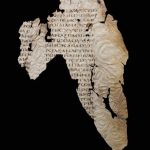| Artefact ID | 475 |
| TM ID | TM 61792 |
| Findspot (DEChriM ID) | 64 (Aswān) | Class | Textual |
| Material | Parchment |
| Writing medium | Codex |
| Text content | Literary |
| Language | Greek, Coptic |
| Description | Emerita 27 (1959): 59-73; Uncial 0242 The parchment fragments (largest piece measuring 21 x 13.5 cm) containing the Gospel of Matthew 8:25-9:2, as well as 13:32-38 and 40-46. The text is arranged in 2 columns per page with approx. 21 lines. The original size is estimated to have been 23 x 20 cm with 25 lines per column; see ed. pr. Above the verses of Matt. 13.33-34, there are references to the canons of Eusebius. Overall, the text is in Greek, but there is a note in Sahidic Coptic in the upper margin of the verso, which appears to be much later than the Greek text. The hand is a Biblical majuscule, and there is no visible punctuation or abbreviations, such as nomina sacra. The text does contain diaereses. |
| Selection criteria | Literary genre (Biblical) |
| Date from | 300 |
| Date to | 399 |
| Dating criteria | Palaeography. Roca-Puig 1959, van Haelst 1976, Aland, Aland 1995 and the INTF agree on a 4th century date, while Trismegistos narrows it down to the second half of the century. This datation makes these fragments the earliest attestation of the "Eusebian canons", also known as "Ammonian sections". The two other early uses of the Eusebian sections are in Uncial 02 and Uncial 04, both dated to the 5th century. |
| Absolute/relative date | Relative date |
| Archaeological context | The provenance is uncertain, but the findspot was Aswān. The sites of ancient Syēnē and Elephantinē are both good candidates. However, the fact that it is Ugo Monneret de Villard's name that appears in the records of the Museum of Egyptian Antiquities in relation to this fragment suggests that it could have been found at the Monastery of St Simeon in Aswān, where Monneret de Villard excavated between 1924 and 1926. |
| Accession number | Alexandria, Bibliotheca Alexandrina, inv. 513 (BAAM 0513; Houghton, Monier 2020: 121). The fragment was previously stored in the Egyptian Museum in Cairo, inv. JdE 71942. |


 Json data
Json data




